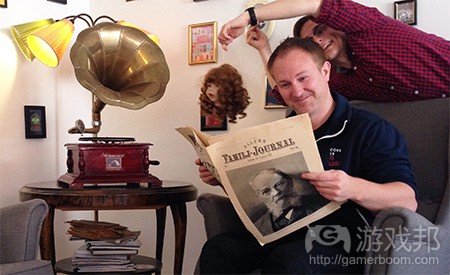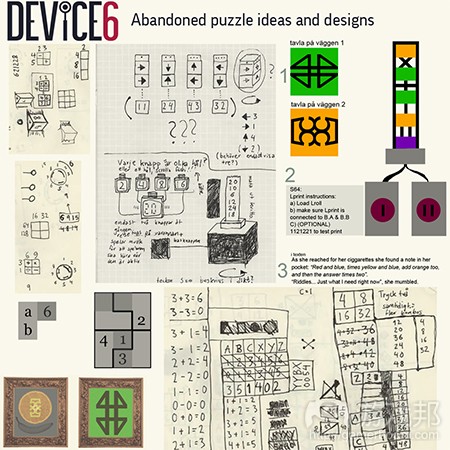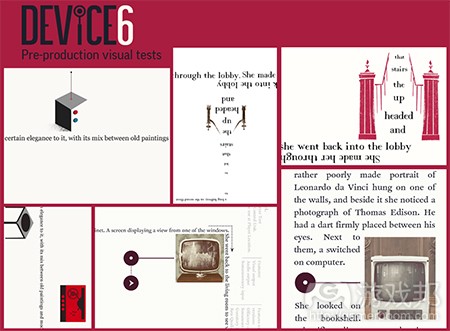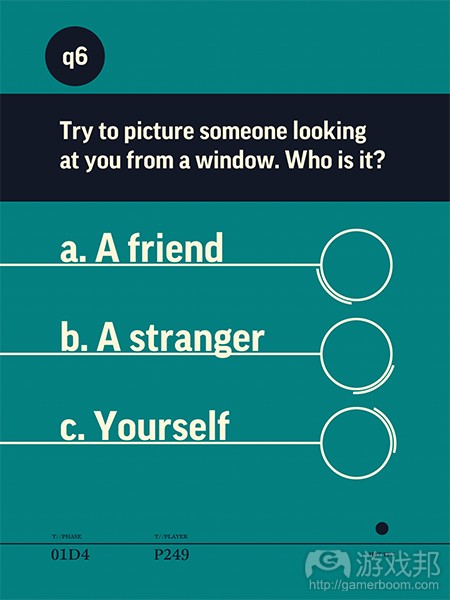《DEVICE 6》开发者分享游戏制作经过
作者:Kirk Mckeand
乍一看,Simogo的最新iOS力作《DEVICE 6》会让人联想到他之前的一款广受好评的游戏《Year Walk》。
仔细观察才发现,这两款游戏确实被一个东西联系起来了。那就是:谜题。
在这款文字冒险游戏中,文字变成玩家前行的路径,玩家通过旋转自己的设备来操作游戏,滚动文本来进展剧情和探索游戏世界。
即使是在这个手机游戏蓬勃发展的时代,这种概念也不可能做成什么游戏的。然而,对于这家瑞典工作室而言,正是《DEVICE 6》帮助他们巩固了最有创意的iOS游戏开发者之一的地位。
原型
Flesser解释道:“当我们完成《Year Walk》,我们发现通过文本叙述故事还有可探索的空间,就像我们做的伴侣应用一样。”
“所以我们开始讨论如何做成一款更有新意的游戏,而不只是一款常规的文字游戏。
“当时我正在阅读Judy Schalansky写的书《Atlas Of Remote Island》。我很喜欢那本书的概念,让我感觉在探索遥远的地方,那种身临其境的感觉甚至比大多数只是让玩家前进和给玩家展示东西的游戏的来得强烈。所以我们开始思考如何让游戏创造那种感觉。
“所以我们讨论了书籍、地图以及如何整合那些材料。最终我们想到了文字地图这个概念。我们发现探索场景一边进展故事的玩法非常有趣。这样玩家就可以同时利用时间和空间了,这是我们认为最有趣的地方。”
(Simogo: Magnus Gardeback(坐下者)和Simon Flesser)
当然,这么野心勃勃的项目的灵感来源不只是一本书。电影《007》和电视剧《迷失》也是点燃了我们的创意火花。
Flesser透露,这些不是确切的影响,但真正的灵感没有
“那时我很迷《囚徒》(游戏邦注:一部英国小说),现在也是。所以我们的游戏受那本书的影响也很大。
“在开发项目期间,我又看了一遍《双峰》,所以游戏应该也受到一点影响。女侦探小说家Agatha Christie的《无人生还》和Franz Kafka的《审判》以及 Dennis Lehane的《禁闭岛》……主要是英国的侦探小说。
“我指的是整体氛围。还有逃离密室类型的游戏,主要是DS的《999》。很不错的一款游戏。”
显然,对《DEVICE 6》产生更直接的影响的是Simogo之前的作品《Year Walk》。就玩家探索游戏世界的方式而言,《Year Walk》奠定了基础。
Flesser承认:“我想你可以很轻易地看出玩家的互动和移动方式有相当类似的。”
“我们很早就决定这款游戏应该分章节,因为开放世界太麻烦了,必须时时担心玩家可能做出什么奇怪的事,而那些事又是不应该发生的。
“我想,突出体验的冒险性和故事性,对这款游戏的帮助也很大。”
解决谜题的工具
游戏的想法构思好以后,Simogo的一支小团队花了六个月的时间完成了游戏的制作。
这个小团队只有6名成员:Simogo的创始人Simon Flesser和Magnus Gordon Gardeb?ck、Jonas Tarestad(编剧)、Daniel Olsén(音乐)、Jonathan Eng(歌曲)和?sa Wallander(LOGO)。
除了这支小团队,其他人也帮了不少忙,比如校正、配音或(更普遍的)记录玩家的偶然发现。游戏中的许多声音是由苏格兰工作室Lucky Frame(代表作《Bad Hotel》)的Yann Seznac提供的。
游戏是用Unity制作的,还配合使用了Maya、Photoshop、Audacity和Audition。此外,在原型阶段还做了很多笔头工作——Simogo是“用简单的工具做概念”的忠实倡导者。
Simogo承认选择使用Unity确实带来了一些问题,但总体上,Flesser很满意这个选择。
“老实说,Unity的字体渲染很糟,所以我们不得不在那里做一些变通。我们自己做了纵对齐;一开始,为了使渲染效果看起来不太坏,我们甚至自己笨手笨脚地编辑字体。
“到项目开发中期,我们使用了文本渲染的插件,彻底抛开Unity的字体渲染。”
Flesser表示他不曾使用过其他引擎,但他自我检讨,认为其实本应该看看其他选择或字体插件。
我抄袭了小说
然而,《DEVICE 6》最大魅力不是它独特的视觉风格,而是游戏的故事;是游戏的故事把这款游戏与其他iOS游戏区别开来。
但尽管故事精彩,Simogo布局剧情的方式与其他游戏并没有太大不同——先罗列游戏想表达的东西,然后做成最终的脚本。
“我们其实是根据自己心中的想法写了故事。我认为这是故事出彩的原因。这款游戏中的一切,包括交互作用、谜题和硬件都是叙述的一部分。《DEVICE 6》就像大部分美术作品一样,是想法的拼贴组合。
“我和Jonas想出故事的大框架,然后Jonas当主笔,我负责编辑和修改。为了配合我们想到的谜题和布局,有时候我的工作量还是很大的。但我们一开始就已经决定好一切了,我甚至画了原图,这样我们对大局就有比较清析的思路。
“《DEVICE 6》和《Year Walk》的做法大致相同,都是先概述故事,再完整故事。我的意思是,当你发现剧情中的漏洞,你必须想办法补上,你会突然发现你解决了不只是一个问题。”
Flesser不认为游戏的故事太含糊,但承认还得多做一次测试才能把所有细节整理好。
“我们发现谜题故事的概念确实有意思。大部分东西就在那里了,但有一点儿支离破碎,我想你得玩上两三次才能把整个故事梳理清楚。我们希望把剧情安排得严密一些,不让玩家觉得太蠢。”
《DEVICE 6》没有告诉玩家故事发生的时代,正是这种手法的体现。
这款游戏的环境让人想到冷战时期——核弹发射器和老旧的录音机都是证据,然而文本旁边显示的设备样图会让所有苹果粉马上就觉得亲切熟悉。
“我们希望模糊故事发生的时间,使它既有强烈的冷战或60年代的氛围,又仍然让人不确定准确的时期。”
这与游戏的现代/冷战时期相融合的氛围形成对比的是,超现代外观的机器娃娃和机体模型又使游戏增加了一丝恐怖的气息。
反馈
Flesser表示:“主人公Anna的某些评论一定程度上就是我想对Jonas说的话,所以有点儿‘游戏中的游戏’的意思。”
“在游戏中的某个时候,她说‘玩偶和模型已经够了’。我的意思是,高科技公司竟会使用这么原始的东西来完成他们的野心,实在太可笑了。”
并不是添加说些奇怪的特征会让制作游戏的所有人感到吃惊。另一个同样怪异的特征是,在章节末尾要求玩家“给这个阶段的游戏打分”。这其实是讽刺那些用消费者评级给应用定生死的公司,如苹果。
但这种测试还有其他目的吗?消费者给出的回答可以当成是真实的反馈吗?
“他们都是叙述的一部分,有助于完善游戏的想法。”Flesser回避了上述信息是否在处理前使用的问题。确实,有一股神秘的气氛笼罩着Simogo——Flesser似乎喜欢吊人胃口。
这其实可以归结为一个事实:Flesser在Simogo并没有正式的头衔,所以给这位特殊的编剧带来了一些困难。
Flesser不愿意给出明确回答,当然是为了避免对那些还没下载游戏的人剧透——这决定了故事导向型游戏的成败。
然而,Flesser大方承认,游戏的故事其实暗暗评论了某些大公司——未必是针对苹果,以及它们的权势。
“我的意思是,你可以当作就是在评论苹果,但我可不承认。游戏的故事讽刺了我们这整个社会,而有些现象正好能对应到剧情。”
他继续解释,他不想说得那么直白,因为他认为玩家自然会想到他们自己的一套理论和解释,但《DEVICE 6》确实揭露了现代技术如吞食信息。
“这款游戏揭露了数字时代发生的现象,拷问了我们漠视的心灵,告诉我们有很多可疑的东西被伪装成娱乐而我们却被默默为这些娱乐埋单。”
灯塔之石
除了整体概念,这家工作室特别关注的一个元素是Jonathan Eng为游戏演唱的原创歌曲(这在游戏中是很少见的,更别说在iOS游戏中)——在游戏中循环播放,让人感到幻觉、沉醉、超现实。
Flesser透露道:“Jonathan的风格很早就确定了,我认为最终效果基本上达到目标了。
“我们只是觉得必须把游戏的表现做好。极少游戏能做到:《寂静岭:破碎的记忆》和《英雄不再》是我能想到的唯一两款游戏。”
这绝对是一个令人难忘的时刻。一旦你听过那首歌,它就会久久地在你脑中徘徊,无尽地循环播放。
“最终效果令人惊艳。Jonathan太棒了。这首歌是由Daniel Olsén制作的,他也负责游戏的其他音乐。他们也分别为《Year Walk》做过东西,不过我们觉得这次让他们合作会非常有意思。”
接下来要做什么呢?“这是一个好问题。现在就是在琢磨几个想法,还不是太确定!可能要一直想到‘下一个大事件’吧,在这期间我们有一些小事想做。只是尝试不同的东西,不一定是游戏。
“小工作室的工作安排就是紧凑!比如,这周我们打算把《DEVICE 6》的原声带做出来。”
无论Simogo接下来想做什么,有一件事是肯定的:我们已经迫不及待地想看看这家工作室书写的下一个章节(新游戏)。(本文为游戏邦/gamerboom.com编译,拒绝任何不保留版权的转载,如需转载请联系:游戏邦)
Textual orientation: The making of DEVICE 6
by Kirk Mckeand
Beyond its intentionally unsettling nature, at first glance DEVICE 6 – Simogo’s latest iOS hit – appears to have little real connection to the studio’s previous critically acclaimed release Year Walk.
Closer inspection reveals that there is, in fact, a thread that ties the two together: puzzles.
DEVICE 6 is a unique spin on the text adventure template, with the words becoming the path along which the player travels, rotating their device and scrolling along the text to both advance the story and explore the world it inhabits.
It’s the kind of concept that, even during this comparatively daring age of mobile development, is unlikely to have made it beyond the drawing board at a bigger outfit. Yet, for this particular Swedish studio, DEVICE 6 has helped cement its position as one of iOS’s most creative forces.
We speak to Simon Flesser, who makes up one half of Simogo, to tell a different story: how DEVICE 6 made the transition from the real pages of its design documents to the fictitious pages the game lays out on iOS.
Prototype device
“When we had finished up Year Walk, we felt that there were still more to explore by telling as story via text, as we had done with the companion app,” explains Flesser.
“So, we started talking about how we’d turn that into more of a game, and not just a regular text based game.
“At the same time I was reading a book called Atlas Of Remote Island, by Judy Schalansky, and I really loved the concept of that book. You feel like you’re remotely exploring places, and the sense of being there is actually stronger than most games that just go ahead and show everything. So we started to think about how that feeling could be captured in a game.
“So we talked about books, maps, and how to merge that. And came up with the concept of text maps. We found it interesting how you’d be moving about in an environment and at the same time progress the story. So the player would actually be ‘scrubbing’ both time and space simultaneously, which we found super fascinating.”
Simogo: Magnus Gardeback (sat down) and Simon Flesser
Of course, a single book wasn’t the only inspiration for such an ambitious and different project. When we played, flickers of James Bond and flashes of TV show Lost appeared to break through.
These aren’t the exact influences, Flesser reveals, but the real inspirations aren’t too far removed.
“I was pretty obsessed, and still am, by The Prisoner at that time,” Flesser says. “So that was a strong influence.
“I re-watched Twin Peaks during the project so that has probably been a bit influential too. Agatha Christie – mainly And Then There Were None – Franz Kafka’s The Trial, Dennis Lehane’s Shutter Island … and just generally British spy fiction.
“I mean, for the general vibe. Escape room type of games too. Mainly 999 for the DS if you’ve played that. It’s great.”
Obviously, a more direct inspiration on DEVICE 6 was Simogo’s previous work with Year Walk, which laid the foundations in regard to the way the player navigates through the game’s world.
“I guess you can easily see how the way you interact and move about is quite similar,” admits Flesser.
“One of the things we decided early on was to divide the game into chapters, as having an open world causes a lot of headaches, in that you have to be very aware of all the weird stuff a player can do, that they’re not supposed to.
“I think just generally the experience of having made something more adventure-ish and story-based helped a lot too.”
Tools to solve puzzles
Once the seed of the idea started to form, it took Simogo – with a small team – six months to finish making the game.
Said team was made up of six people: the founders of Simogo, Simon Flesser and Magnus “Gordon” Gardeb?ck, Jonas Tarestad (writer), Daniel Olsén (music), Jonathan Eng (one song) and ?sa Wallander (the logo).
As well as the main team, others also helpedout with proofreading and providing the voices for the various characters or (more commonly) recordings the player stumbles across. Many of the voices were provided by Yann Seznac from Scottish studio Lucky Frame of Bad Hotel fame.
The game was made in Unity, with the addition of Maya, Photoshop, Audacity and Audition also thrown in for good measure. On top of this, there was a lot of pen and paper planning during the prototype stages – as a rule, Simogo is a big fan of conceptualising with simple tools.
The studio admits opting to use Unity did throw up a few problems, but overall, Flesser was happy with the firm’s choice of tools.
“Font rendering was, to be frank, very poor in Unity,” admits Flesser. “So we had to go through some hoops there. We had to make our own column alignment, and at start we even had to edit the font in odd ways to make it render in way that just didn’t look awful.
“We ended up using a plug-in for text rendering, ditching Unity’s font rendering altogether, in the middle of the project.”
Flesser says he wouldn’t have used a different engine but, in retrospect, he would have explored other options or plug-ins for font rendering.
I spy fiction
The main draw of DEVICE 6 isn’t in its unique visual style, however. Rather, the big pull is the game’s story, which – along with the way it’s told – helps set the game apart from other iOS efforts.
Despite the story’s prominence, however, the way Simogo approached laying out the game’s narrative wasn’t all too different to that of any other title. The studio started with a list of things it wanted to portray in the game before settling on a final script.
“We actually wrote the story to fit the ideas and messages we had in mind,” says Flesser. “And I think that’s why it works so well. Everything in the game, including interactions, puzzles and the hardware is part of the narrative. It’s a collage of ideas and things, like most pieces of art or products tend to be.
“Me and Jonas outlined the story and then Jonas wrote most of them, with me acting as sort of an editor, and rewriting things, sometimes really large portions, to fit the puzzles and layouts we had in mind. But we had decided upon everything first, and I even drew primitive maps so we’d get a sense for everything.
“I think the case for both DEVICE 6 and Year Walk has been that the story has been outlined, and then out of luck story bits fall into places. I mean, when you find holes in the plot, and you have to fill those in some way, and then all of a sudden it solves more than one problem.”
Flesser doesn’t believe the story is vague, but admits that it would take more than one playthrough to piece the whole thing together.
“We find the concept of a puzzle story really fascinating,” says Flesser.
“Most things are actually there, but it’s a bit fragmented, and I guess you’d have to play it two or three times to piece it all together. We like to keep things a bit elegant and not let the players feel stupid.”
Such an approach is evident in the way DEVICE 6 chooses not to inform the player what time period it’s set within.
The game’s surroundings give off an undoubted Cold War vibe – missile launchers and crackled voice recordings all in check – yet the blueprints for the devices that show up at the side of the text will looks instantly familiar to any Apple aficionado.
“That’s another thing that we wanted to be really vague,” says Flesser. “We wanted it to have this very strong Cold War or 1960s vibe, but still be very ambivalent about when it’s actually set.”
And contrasting with this modern day/Cold War mash-up, there’s the otherworldly appearance of creepy robotic dolls and mannequins, giving the game a horror edge.
War is cold
“Some of Anna’s – the protagonists – comments are actually just my comments to Jonas in a way, so that’s a bit meta too,” says Flesser.
“She says ‘enough with the dolls and mannequins already’, somewhere in the game. I mean, it’s just wonderfully absurd how a high tech corporation would use something as primitive as dolls in their endeavours.”
Not that the addition of such strange characteristics should surprise anyone that’s taken on a Simogo title. Equally eerie – asking how players “rate the game so far” at the end of chapters. It’s a move devised to comment on companies like Apple who, for better or worse, live and die by the ratings of their customers.
But does this test serve another purpose? Are the answers given used as genuine feedback?
“They are all part of the narrative, and there to power the ideas of the game” says Flesser, sidestepping the issue of whether said information is used before being disposed of. Indeed, there’s an air of mystery around Simogo that, it seems, Flesser enjoys portraying.
It’s something that extends down to the fact that Flesser has no official title at Simogo – a fact that caused this particular writer a few difficulties, it has to be said.
Much of Flesser’s reluctance to give definitive answers, of course, stems from an intention to avoid spoiling the game for those yet to download it – something that’s especially key for a game built around narrative.
Flesser is willing to admit, however, that the story is a comment on big corporations – not necessarily Apple – and the power they hold.
“I mean, you can look at it as if it’s a comment on Apple specifically, but I don’t think it is,” reveals Flesser. “It’s more of a comment on a lot of things in our society as whole, and some of the things fit the bill.”
He goes on to explain that he doesn’t want to spell it out completely, as he would like the community to come up with its own theories and interpretations, but DEVICE 6 certainly makes reference to how modern technology eats information.
“It’s a game very much questioning things that are happening in the digital age,” says Flesser. “And how very few don’t really care anyway, and how a lot of questionable things are being disguised as entertainment, and in what means you are paying for this entertainment.”
Lighthouse rock
Besides the general concept, one element the studio was especially keen to get into play was a song performed by Jonathan Eng – a looping performance of an original song performed for the game (a rare occurrence in games in general, but even more so for iOS ) that’s hypnotic, catchy and strangely surreal.
“The scene with Jonathan was decided really early on,” reveals Flesser. “I think actually most of the things made it in, in the end.
“I think we just thought the idea of having a proper performance in the game was very appealing. Very few games have done that: Silent Hill: Shattered Memories and No More Heroes are the only ones I can think of.”
It’s definitely a memorable moment. One that ensures the song in question will refuse to leave your head for day after hearing it, looping endlessly.
“It turned out very very good,” Flesser says. “Jonathan [Eng] is amazing. It was produced by Daniel Olsén, who made the rest of the music in the game. They made stuff for Year Walk too last time, but we thought it’d be fun to bring them together this time.”
And what about next time? “That’s a good question,” says Flesser. “Tossing a few ideas around at the moment. Not quite sure! It’ll probably be a bit until ‘The Next Big Thing’ – we have a few small things we want to do in between. Just trying out different stuff, not necessarily games.
“Being such a small studio everything takes time! This week we’re hoping to have the DEVICE 6 soundtrack out, for example.”
Whatever Simogo does decide to do next, one thing’s for sure: we can’t wait to turn the page on the studio’s next chapter.(source:pocketgamer)












































 闽公网安备35020302001549号
闽公网安备35020302001549号